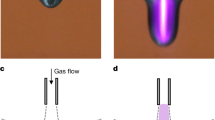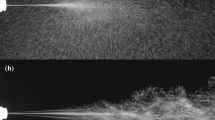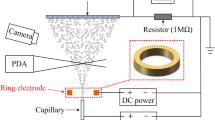Abstract
The disruption of a liquid into a spray of charged droplets, when subjected to an intense electric field, has attracted considerable interest from both a fundamental and applied point of view. On the applied side, the process has been used in paint spraying, electrostatic printing, electrostatic emulsification, fuel atomization in combustion systems and in space vehicle propulsion systems. More recently, the phenomenon has found potential application in crop spraying because of the low energies required, the ability to produce fine sprays within a narrow size distribution and the preferential deposition on the target surfaces. Despite its wide range of applications, the mechanism of liquid disruption is only poorly understood. At a critical potential, the so-called Taylor1 cone develops, with a fine stable jet issuing from its tip. The formation of such cones and jets is essential for the production of an electrohydrodynamic spray. Most previous work aimed at understanding jet formation has been based on high-speed photographic techniques. We have made direct observations of jet formation and our results, presented here, demonstrate the role of electrical shear effects in this process, and invalidate those theories that assume a uniform velocity profile2 for the liquid in the conical base of the jet.
This is a preview of subscription content, access via your institution
Access options
Subscribe to this journal
Receive 51 print issues and online access
$199.00 per year
only $3.90 per issue
Buy this article
- Purchase on Springer Link
- Instant access to full article PDF
Prices may be subject to local taxes which are calculated during checkout
Similar content being viewed by others
References
Taylor, G. I. Proc. R. Soc. A280, 383–397 (1964).
Horning, D. W. & Hendricks, C. D. J. appl. Phys. 50,(4), 2614–2617(1979).
Bailey, A. G. Phys. Bull. 35, 146–148 (1984).
Melcher, J. R. & Taylor, G. I. A. Rev. Fluid Mech. 1, 111–146 (1969).
Hayati, I. J. Fluid Mech. (submitted).
Kozhenkov, V. I. & Fuks, N. A. Russ. Chem. Rev. 45, 1179–1184 (1976).
Gibbs, J. W. Collected Works Vol. 1, 301 (Dover, New York, 1961).
Adamson, A. W. Physical Chemistry of Surfaces, 110 (Wiley, New York, 1976).
Author information
Authors and Affiliations
Rights and permissions
About this article
Cite this article
Hayati, I., Bailey, A. & Tadros, T. Mechanism of stable jet formation in electrohydrodynamic atomization. Nature 319, 41–43 (1986). https://doi.org/10.1038/319041a0
Received:
Accepted:
Issue Date:
DOI: https://doi.org/10.1038/319041a0
This article is cited by
-
Numerical Simulation and Optimization of Stable Coaxial Jet Formation and Direct-Write Printing Array Nanoarchitectonics
Journal of Electronic Materials (2024)
-
Stabilization of liquid instabilities with ionized gas jets
Nature (2021)
-
Electrospray patterning of yeast cells for applications in alcoholic fermentation
Scientific Reports (2019)
-
Characterization and Analysis of Paper Spray Ionization of Organic Compounds
Journal of the American Society for Mass Spectrometry (2018)
-
Electrospray Generated from the Tip-Sealed Fine Glass Capillary Inserted with an Acupuncture Needle Electrode
Journal of the American Society for Mass Spectrometry (2018)
Comments
By submitting a comment you agree to abide by our Terms and Community Guidelines. If you find something abusive or that does not comply with our terms or guidelines please flag it as inappropriate.



